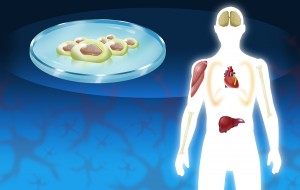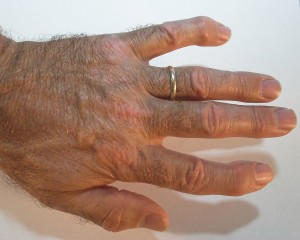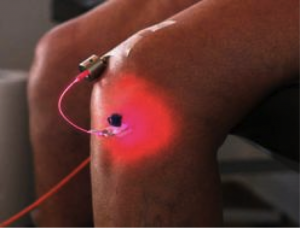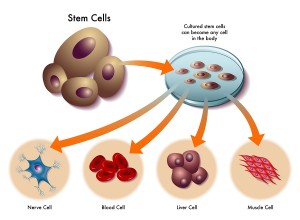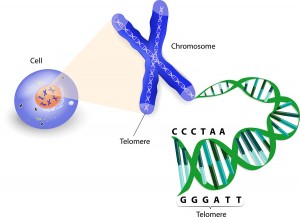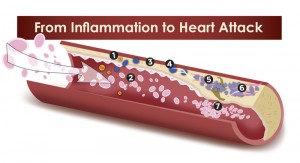We all age; but can we rejuvenate with stem cells? There is a limit to detoxification, to eating organic food, to exercising, to the effects of vitamins and supplements and even to the effect of bioidentical hormone replacements. The limit comes from our telomeres and from stem cells that get depleted in our body as we age. Some researchers report that in regions where we suffer from a disease stem cells are even more depleted than in the rest of the body.
We do not have all the answers yet. We would like to know why our stem cells in the fatty tissue or in the bone marrow do not migrate on their own into an aching back or a sore shoulder. There are all the aches and pains associated with old age. So, why do our own stem cells not help us? They seem to be locked away in fatty tissue and in bone marrow.
At the 22nd Annual World Congress on Anti-Aging Medicine in Las Vegas (Dec. 10-14, 2014) I learnt that there is a group of stem cell experts in California with affiliates all over the US. They simply take stem cells from the fatty tissue and sometimes also from the bone marrow, isolate the stem cells through a stem cell separator and infuse the stem cell rich fraction (minus fatty and connective tissue) in a bit of saline solution back into the vein of the patient. When the stem cells are in the blood stream, they get activated by the growth factors that are present in blood and can now find where they are needed and start the healing process.
Studies have shown that when stem cells are in circulation in the blood, they are very sensitive to signals from tissues that indicate that there is an inflammatory process. This is why stem cells will repair arthritic changes. The can repair a torn meniscus, a rotator cuff tear in the shoulder or repair a weak immune system. The interesting observation is that stem cells from fatty tissue, also termed mesenchymal stem cells, are pluripotent. This means they can develop into cartilage building cells (chondrocytes) and build up cartilage; this is badly needed in a person with severe osteoarthritis. But stem cells are flexible: they can turn into meniscus cells in a knee with a torn meniscus. They also can repair the damage and relief the patient of the chronic pain. In a shoulder with a rotator cuff tear they can turn into a tough ligamentous material mending the tear.
Some data even indicates that circulating stem cells can repair vital organs like the brain, heart, liver, kidneys and bone marrow; these latter observations were mostly done in animal experiments, but human data is starting to be published in the medical literature.
So, let’s examine what has been found useful with regard to stem cells that are taken from your fatty tissue or your bone marrow and injected into one of your veins.
Here is a website from Arizona that I am only showing as a typical example (I have no conflict of interest and no commercial connections to this group) of what I described above.
With websites like this it is also important to read the disclaimer: “Even though our treatments are done using autologous cells, our Stem Cell Therapies are not approved by the FDA. Stem Cell Treatments are not a cure for any condition, disease or injury, nor a substitute for proper medical diagnosis and care…” Another website from La Quinta, CA describes the use of mesenchymal stem cells for regenerative therapies.
Stem cell treatments are in flux. There is a large body of knowledge that has accumulated showing that with proper technique and aseptic conditions it is a safe procedure. The FBA has been watching this. There are publications regarding the safety of procedures with adipose mesenchymal stem cells; here is one example.
The next step is to show in clinical trials that a certain procedure with stem cells is effective in treating a certain condition.
Below I did a literature review, which are only a few examples, but does not claim to be complete; it highlights some of the problems with stem cell treatments.
Stroke treatment with intravenous administration of bone marrow mononuclear stem cells
This study from India showed no statistical difference of stroke patients treated intravenously with bone marrow derived mononuclear stem cells (the experimental group) and the control group that did not receive such treatment. The investigators examined both groups with functional brain tests and performed PET scans to look at the healing of the brain lesions. Unfortunately the tests showed no statistical difference, but did show that the stem cell procedures were safe. It may be that the wrong stem cells were used (mononuclear bone marrow stem cells) when adipose derived mesenchymal stem cells may have done better. In stark contrast to the study from India is the stem cell treatment for a severe stroke in the former hockey player, Gordie Howe that has gone through the media recently. His procedure was done in Mexico. The stem cells were administered via a lumbar puncture approach as well as intravenously. As you can see from this case, stem cell treatment is even possible in patients who are in their mid 80’s with impressive results.
Parkinson’s disease
Here is a feasibility study from March 2014. A 71-year-old Asian man with progressive supranuclear palsy, an aggressive form of Parkinson’s disease was treated with adipose tissue-derived mesenchymal stem cells that were administered intravenously and intrathecally (to get stem cells into the cerebrospinal fluid that bathes the brain). A remarkable functional recovery took place.
Possible side-effects
This is a report of pulmonary embolism after administering intravenous adipose tissue-derived stem cell therapy. The blood clots in the lungs were treated with anticoagulant therapy. Repeat CT scans of his lungs showed later that the emboli were dissolved spontaneously. It is not clear whether this was a case where familial clotting problems pre-existed as a relative of this patient experienced a similar occurrence after stem cell therapy as well.
A case of chronic autoimmune thrombocytopenic purpura
A rare form of autoimmune disease exists where the body forms antibodies against platelets that help your blood to clot. Here is a paper from June 2009 that describes how a man with this disease was cured using adipose tissue-derived mesenchymal stem cells that were injected intravenously.
Renal transplant survival in type 1 diabetes patient
This case report from India shows that adipose tissue derived mesenchymal stem cells that were given at the time of a kidney transplant to treat end stage kidney disease. The treatment stabilized the condition of this patient after a kidney transplant. At the same time some of the mesenchymal stem cells differentiated into insulin producing cells, which made it much easier to control this patient’s diabetes. In this case stem cells were providing stability following an organ transplant (kidney) and some stem cells turned into insulin producing pancreatic cells.
Osteonecrosis of hip treated with adipose tissue derived MSC
In this study from South Korea dated January 2012 two cases of osteonecrosis of the hip, where the hipbone died (osteonecrosis) are described. The following stem cell protocol helped: The fraction that contained the stem cells (called stromal vascular fraction) was mixed with platelet rich plasma and hyaluronic acid. Using a long needle this mixture was injected into the affected hip joint. Conventional medicine has nothing to offer except a total hip replacement. But here are two cases that showed complete resolution of their pain, regained hip function completely, and healing could be documented with the help of MRI scans.
Treating heart attack patients with stem cells
Here is a paper from The Netherlands, published in June 2014 that describes the problems with stem cell treatment in humans. It points out that much has been learnt from animal experiments. The problem following a heart attack is that there is a massive inflammatory response in the infarcted heart muscle, which makes it difficult for stem cells to establish themselves in the injured heart muscle. However, stem cells have been shown to prevent the development of cardiomyopathy that follows a massive heart attack and often is the cause of death. More refinements are needed for successful treatments, such as the ideal timing of stem cell injections in relationship to the time of the heart attack, the best treatment approach and what number of stem cells to inject are all questions that still need to be answered.
MS model in mice shows promise with adipose mesenchymal stem cells
Experimental encephalitis in mice is used as a model for MS in humans. It helps to preselect potentially effective treatments for MS in humans. In this 2013 paper from Australia researchers used mesenchymal stem cells from adipose tissue and injected them intravenously. To their surprise the mesenchymal stem cells were able to penetrate the blood/brain barrier and end up in the myelin lesions inside the brain. In contrast, bone marrow derived stem cells were unable to do that. The researchers stated that adipose mesenchymal stem cells should be considered “as a cell therapeutic that may be used to treat MS patients”.
A group from Iran published this paper in February 2015 further emphasizes that mesenchymal stem cells would be a logical way to treat MS in humans.
Immunosenescence
As we get older the immune systems weakens because of a process called immunosenescence.
A research group from Austria published a paper in December 2011 that is typical for the thinking that mesenchymal stem cells from fatty tissue have properties that help the immune system to get stimulated. Based on this human data it should be possible to stimulate the immune system by giving stem cells from the fatty tissue to the same person intravenously. This publication shows that this process, which would benefit people above the age of 50 or 60 when the immune system gets weaker, will indeed stimulate the immune system. However, at this point we do not have the data of large clinical trials where this would have been done with measurements of the immune function before and on several occasions after stem cell injection to get a feeling for how long the effect would last. We also do not know whether this procedure is associated with longevity.
Conclusion
Stem cell therapy is definitely coming and many applications are already established as I discussed in a prior blog. It is only recently that physicians are no longer worried about creating tumors with stem cell transfer. Now we are in a phase where various stem cell transfer methods (intravenous, intrathecal, interstitial) are being tested as a treatment for various illnesses. It looks like stem cells from fatty tissue may soon be used intravenously, but I have not seen any such trials when checked on PubMed. The activation of stem cells by laser light has only been mentioned sparingly in the literature. This combination (laser activated, intravenous mesenchymal injection) has the potential for being useful for a multitude of chronic illnesses like fibromyalgia, MS, generalized arthritis, just to mention a few. Mesenchymal stem cells are anti-inflammatory, and they can mend defects without leaving scars.
